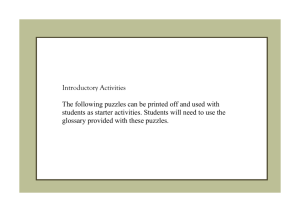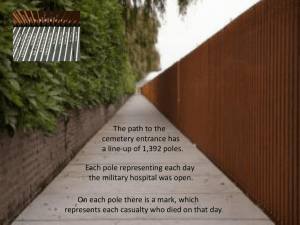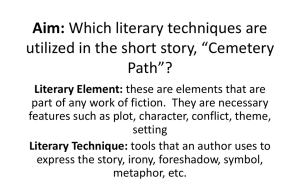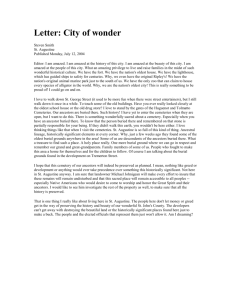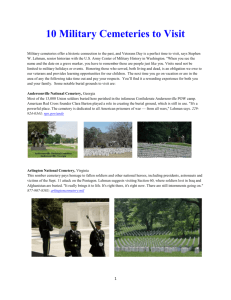Student worksheetsNC - Historic Cemeteries Conservation
advertisement
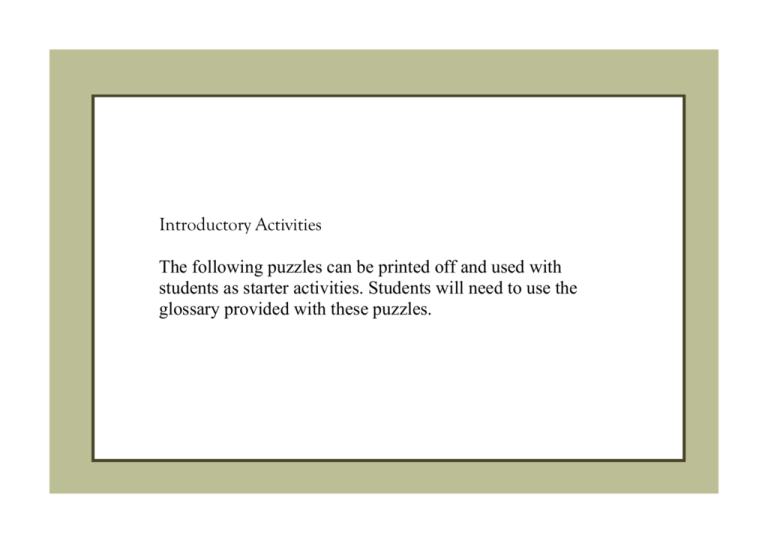
Introductory Activities The following puzzles can be printed off and used with students as starter activities. Students will need to use the glossary provided with these puzzles. Student Worksheets: Scrambled word puzzle Cemetery words All the scrambled words are from the glossary and are words that we use about items found in a cemetery. Unscrambling the words and use the clues to solve the sentence at the foot of the puzzle. Student Worksheet: Crossword - Memorials come in all shapes and sizes 4 6 8 5 9 1 An underground room or cellar, often in a church or cemetery used as a burial place. 3 2 10 6 7 Cemetery Words: Glossary (From Betteridge, 2005) Altar tomb Burial A solid rectabgular raised tomb or grave marker resembling ceremonial alters of classical antiquity and Judeo –Christian burial The act of burying ( of a dead body). Cemetery An area set aside for burial of the dead. Cenotaph A monument, usually of imposing scale, erected to commemorate one whose burial remains are at a separate location, literally means ‘empty tomb’. Usually applied to monuments such as war memorials. The box or case in which a body is placed for burial. Coffin Columbrium, Columbrium Wall, Niche wall Column Crypt Deceased Epitaph Funeral Director Grave Headstone A sepulchral vault or other structure with recesses or niches in the walls to receive the ashes of the dead. From the Latin word columba, a dove, relating to the fact that some columbrian walls are like dovecots or pigeon lofts. A pillar or tall vertical circular structure sometimes presented as broken especially when life has been cut short or a person has died at a young age. A subterranean chamber or vault, especially one beneath the main floor of a church, used as a burial place. Person who has died. Wording on a headstone or other grave monument identifying or commemorating the dead. Sometimes a poem, saying, or bible verse is used for example, “Thy will be done” A professional person with responsibility for arranging funerals. People in this profession were known as undertakers during the 19th and 20th centuries. Any place of internment or burial Inscription An upright stone marker placed at the head of the deceased, usually inscribed with demographic information, epitaphs or both, sometimes decorated with a carved motif. An everlasting plant or flower. In cemeteries the word usually applies to an arrangement of artificial flowers of tin or ceramic within a glass dome placed on top of a grave. Wording on the gravestone or memorial Interment Burying or interring Inurnment The act of placing ashes in a funeral urn. Commonly used to describe the act of placing ashes in a grave or columbrium. Immortelle Cemetery Words: Glossary Continued (From Betteridge, 2005) Ledger Mausoleum Memorial Monument Monumental mason Obelisk Obituary Pedestal Inserted plaque into a memorial often of different or contrasting coloured stone on which the inscription is written. A building above the ground with places for emtombment of the dead. Something designed to preserve the memory of a person, event, etc such as a momument or periodic observance. A structure such as a headstone, column, obelisk, tomb, arch, or cenotaph erected to the memory of a person or event. A tradesperson skilled in the building of monuments, particularly grave monuments A four sided tapering shaft, having a pyramidal point. A monument popularised by romantic taste for classical imagery. A notice of the death of a person, often with a biographical sketch, as in a newspaper. Plot A monument with four faces. Hard flat vertical sides often surmounted with a column, obelisk, urn, cross or statue such as woman or angel etc. The area of land for a grave Sacred Worthy of awe and respect, in honour of. Sarcophagus A stone coffin or monumental chamber for a coffin Sepulchre A tomb, grave or burial place. Sexton Traditionally a digger of graves and supervisor of burials in a cemetery Statuary Often placed on top of a pedestal and taking the form of a woman, angel, cherub etc Stele Stelae An upright slab of stone bearing an inscription and usually a sculptural design, as in traditional headstones and footstones. From the Greek word for a standing block of stone. Plural of Stele Stone mason A tradesperson skilled in working with stone. Tomb A grave or mausoleum Undertaker Old term for a funeral director. Person who arranges funerals Vault A burial chamber, either above or underground. Usually refers to a roofed masonary structure, with shelves to accept coffins. Using Cemetery Maps The following pages are copies of maps (both aerial and schematic versions) for Dunedin’s Northern Cemetery and some student activities. Students use both map types for name and locate activities. The second locate activity can also be used as an extension activity if students finish early at the cemetery. Northern Cemetery aerial photograph: Student worksheet 1 Cemeteries are laid out with sealed roads and grass paths, and in blocks and individual sections called plots in much the same way as a suburb in a town. Each block and plot is numbered. 2 Use the schematic map (next worksheet) to help answer these questions 3 1. Locate blocks 1,2,3 & 4, on this aerial map. 2. What blocks are inside the circle labelled 4 and triangle 5? 5 Key to Map 1 4 2 3 Car park Modern memorial to Thomas Bracken Sexton’s cottage, now an interpretive centre + toilets Overview photograph of Dunedin’s Southern Cemetery provided by the Dunedin City Council. Used with permission. Northern Cemetery Schematic Map Activities– Student worksheet This map, shows a section only of the Northern Cemetery in Dunedin. This is a schematic map showing a similar area of Dunedin’s Northern Cemetery as the aerial map. The map shows the location of Block numbers. To find an individual grave or plot within the cemetery you may need to look at the mortuary records. Keeping track of where everyone was buried was one of the jobs of the cemetery sexton. Today we can check where people are buried online by using the City of Dunedin Cemeteries database at http://www.dunedin.govt.nz/lgovtdb/cemetery/registers_cemetery.dcc Or the northern Cemetery database at http://www.southernheritage.org.nz/northerncemetery/application/search /search.htm Find the following people and mark them with a dot on the map on the left. Find these graves when you visit the cemetery. Robert A Lawson who designed many of Dunedin’s fine old buildings including the Dunedin Town Hall and Otago Boys’ High School, is buried in Block 8 Plot 7. 1 2 Sir Thomas MacKenzie who was a Prime Minister and High Commissioner for New Zealand, is buried in Block 43A Plot 0 3 Alexander Livingston who was drowned in the wreck of the S.S.Tairoa is buried in Block 2 Plot 16 William Cutten arrived in Otago on the John Wickliffe and married a daughter of Captain Cargill. With Julius Vogel he established the Otago Daily Times newspaper in 1861. He is buried in Block 3 Plot 7 4 Portion of a block map of Dunedin’s Northern cemetery. Sourced from the Northern Cemetery. Southern Heritage Trust. Dunedin At the cemetery: Internet references for student inquiry and extension work: Encourage students to find out more about the people who are buried ad commemorated here. 1. There are a number of young men in this area killed in action and interred in commonwealth war graves. The following websites are recommended for students a. The Commonwealth War Graves Commission website is searchable at http://www.cwgc.org/debt_of_honour.asp?menuid=14 Students can find out where these men are actually buried and other military details such as rank, and battalion or regiment served. b. The Auckland Museum Cenotaph Database is also searchable and is at http://muse.aucklandmuseum.com/databases/cenotaph/locations.aspx 2. The Northern Cemetery online database is searchable http://www.northerncemetery.org.nz/northerncemetery/application/dynamic/contacts.cfm and it is worth searching for any existing biographical details. Search by surname first and then when name and plot match check the link to biography. 3. It is often useful to search the City of Dunedin Cemeteries Database if students wish to find out about the occupation and origin of the early settlers on these in depth study areas. These details are not always included but often are, especially for a male. City of Dunedin Cemeteries Database http://www.dunedin.govt.nz/facilities/cemeteries/cemeteries_search The cemeteries database is harder to use than the Northern Cemetery database because it includes people from all 17 of Dunedin’s cemeteries. 4. The National Library Papers Past website is an excellent primary source to find out about accident deaths. Available at http://paperspast.natlib.govt.nz/ Papers Past contains more than one million pages of digitised New Zealand newspapers and periodicals. The collection covers the years 1840 to 1915 and includes publications from all regions of New Zealand. Student Worksheet: Scatter plot template for graph for age at death and decade of death (Adapted from Sagazio, 1992) AGE 100 - 90 89 - 80 79 - 70 69 - 60 59 - 50 49 - 40 39 - 30 29 - 20 19 - 10 1–9 0-1 YEAR 1850 1859 1860 1869 1870 1879 1880 1889 1890 1899 1900 1909 1910 1919 1920 1929 1930 1939 1940 1949 1950 1959 1960 1969 1970 1979 1980 1989 19902000 20002010

